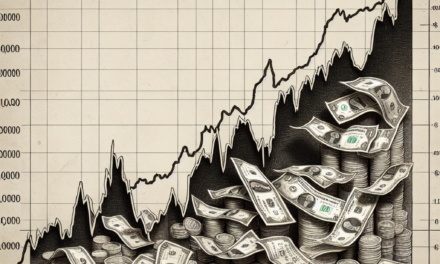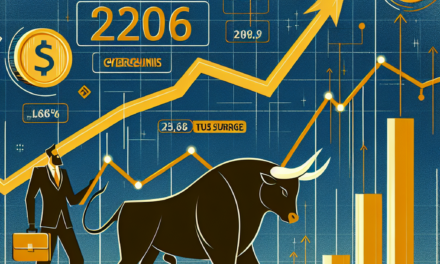“Maximize Your Savings: Discover Top Money Market Accounts Offering 5.00% APY!”
Introduction
As of November 10, 2024, money market accounts are offering competitive interest rates, with top accounts providing an attractive 5.00% annual percentage yield (APY). These accounts, known for their blend of savings and checking account features, are becoming increasingly popular among savers looking to maximize their returns while maintaining liquidity. The current economic climate, characterized by fluctuating interest rates and market conditions, has prompted financial institutions to offer higher yields to attract depositors. This trend presents a lucrative opportunity for individuals seeking to grow their savings with minimal risk. As you explore your options, it’s essential to compare the terms and conditions of various money market accounts to ensure you select the one that best aligns with your financial goals.
Understanding Money Market Accounts: Key Features and Benefits
Money market accounts (MMAs) have long been a popular choice for individuals seeking a secure and flexible way to grow their savings. As of November 10, 2024, the financial landscape has seen a notable shift, with some top money market accounts offering an impressive 5.00% annual percentage yield (APY). This development has sparked renewed interest in MMAs, prompting many to explore their key features and benefits. Understanding these aspects is crucial for anyone considering this financial product as part of their savings strategy.
To begin with, money market accounts are a type of deposit account offered by banks and credit unions. They combine features of both savings and checking accounts, providing account holders with the ability to earn interest while maintaining easy access to their funds. One of the primary attractions of MMAs is their competitive interest rates, which are typically higher than those offered by traditional savings accounts. The current offering of a 5.00% APY is particularly enticing, as it allows savers to maximize their returns in a relatively low-risk environment.
In addition to attractive interest rates, money market accounts offer a high degree of liquidity. Account holders can usually access their funds through checks, debit cards, or electronic transfers, making it convenient to manage their money. This flexibility is especially beneficial for individuals who may need to access their savings for unexpected expenses or opportunities. However, it is important to note that MMAs are subject to federal regulations that limit certain types of withdrawals and transfers to six per month. This limitation encourages savers to use the account primarily for saving rather than frequent transactions.
Another key feature of money market accounts is their safety. Like other deposit accounts, MMAs are insured by the Federal Deposit Insurance Corporation (FDIC) for banks or the National Credit Union Administration (NCUA) for credit unions, up to the standard limit of $250,000 per depositor, per institution. This insurance provides peace of mind, ensuring that account holders’ funds are protected in the unlikely event of a bank failure. Consequently, MMAs are considered a low-risk investment option, appealing to conservative savers who prioritize security.
Moreover, money market accounts often require a higher minimum balance compared to regular savings accounts. This requirement can vary significantly between institutions, with some demanding a minimum deposit of several thousand dollars. While this may be a barrier for some, it also means that MMAs are well-suited for individuals with larger sums of money to save, who can take full advantage of the higher interest rates offered.
In conclusion, money market accounts present a compelling option for savers seeking a balance of high returns, liquidity, and security. The current offering of a 5.00% APY makes them particularly attractive in today’s financial climate. By understanding the key features and benefits of MMAs, individuals can make informed decisions about incorporating these accounts into their overall financial strategy. As always, it is advisable to compare different institutions and account offerings to find the best fit for one’s specific needs and financial goals. With careful consideration, money market accounts can be a valuable tool in achieving long-term financial success.
Comparing Top Money Market Accounts Offering 5.00% APY
In the ever-evolving landscape of personal finance, money market accounts (MMAs) have emerged as a popular choice for individuals seeking a balance between liquidity and higher interest rates. As of November 10, 2024, several financial institutions are offering competitive annual percentage yields (APYs) on their money market accounts, with some reaching as high as 5.00%. This development presents an attractive opportunity for savers looking to maximize their returns while maintaining easy access to their funds.
To begin with, it is essential to understand what sets money market accounts apart from other savings vehicles. Unlike traditional savings accounts, MMAs typically offer higher interest rates, which are often comparable to those of short-term certificates of deposit (CDs). However, unlike CDs, money market accounts provide the flexibility of limited check-writing capabilities and debit card access, making them a versatile option for managing both short-term and long-term financial goals.
In the current financial climate, the appeal of a 5.00% APY cannot be overstated. This rate significantly outpaces the national average for savings accounts, which hovers around 0.40% APY. Consequently, individuals who opt for a money market account with a 5.00% APY can enjoy a substantial boost in their savings growth. For instance, a deposit of $10,000 in such an account would yield approximately $500 in interest over the course of a year, assuming the rate remains constant.
Several financial institutions are leading the charge in offering these competitive rates. Among them, online banks and credit unions are particularly noteworthy. These institutions often have lower overhead costs compared to traditional brick-and-mortar banks, allowing them to pass on the savings to their customers in the form of higher interest rates. Furthermore, many of these online entities provide user-friendly digital platforms, making it convenient for account holders to manage their finances from anywhere.
While the allure of a high APY is undeniable, it is crucial for potential account holders to consider other factors when selecting a money market account. For instance, some accounts may require a minimum balance to qualify for the advertised rate. Failing to meet this requirement could result in a significantly lower APY or even incur monthly maintenance fees. Additionally, it is important to review the account’s transaction limitations, as federal regulations typically restrict the number of withdrawals or transfers from a money market account to six per month.
Moreover, prospective account holders should evaluate the financial institution’s overall reputation and customer service quality. Reading reviews and seeking recommendations can provide valuable insights into the experiences of other customers. It is also advisable to verify that the institution is insured by the Federal Deposit Insurance Corporation (FDIC) or the National Credit Union Administration (NCUA), ensuring that deposits are protected up to the maximum allowable limit.
In conclusion, the current offerings of money market accounts with a 5.00% APY present a compelling opportunity for savers to enhance their financial portfolios. By carefully considering factors such as minimum balance requirements, transaction limitations, and the institution’s reputation, individuals can make informed decisions that align with their financial objectives. As the financial landscape continues to evolve, staying informed about the latest trends and offerings in money market accounts will empower savers to make the most of their hard-earned money.
How to Choose the Best Money Market Account for Your Needs
In the ever-evolving landscape of personal finance, selecting the right money market account (MMA) is crucial for maximizing your savings. As of November 10, 2024, some of the top money market accounts are offering an impressive 5.00% annual percentage yield (APY), making it an opportune time to evaluate your options. However, choosing the best account for your needs involves more than just considering the APY. It requires a comprehensive understanding of various factors that can influence your decision.
To begin with, it is essential to understand what a money market account is and how it differs from other savings vehicles. MMAs are a type of savings account that typically offer higher interest rates than traditional savings accounts, while also providing limited check-writing and debit card capabilities. This combination of features makes them an attractive option for individuals seeking both liquidity and higher returns. However, the benefits of an MMA can vary significantly depending on the institution offering the account.
When evaluating money market accounts, the APY is undoubtedly a critical factor. A higher APY means your money will grow faster, which is particularly appealing in today’s economic climate where inflation can erode purchasing power. Nevertheless, it is important to consider the conditions attached to these rates. Some accounts may require a substantial minimum balance to qualify for the highest APY, while others might offer a tiered interest rate structure that varies based on your account balance. Therefore, assessing your financial situation and determining how much you can comfortably maintain in the account is a prudent first step.
In addition to the interest rate, fees associated with the account should be carefully examined. Some money market accounts impose monthly maintenance fees, which can significantly diminish your earnings. However, many institutions offer ways to waive these fees, such as maintaining a minimum balance or setting up direct deposits. It is advisable to compare the fee structures of different accounts and choose one that aligns with your financial habits and goals.
Another important consideration is the accessibility of your funds. While money market accounts offer more flexibility than certificates of deposit (CDs), they still have limitations. Federal regulations typically restrict the number of certain types of withdrawals and transfers you can make each month. Therefore, if you anticipate needing frequent access to your funds, it is crucial to understand these limitations and choose an account that offers the level of accessibility you require.
Furthermore, the reputation and stability of the financial institution should not be overlooked. Opting for an account with a well-established bank or credit union can provide peace of mind, knowing that your funds are secure. Additionally, ensuring that the institution is insured by the Federal Deposit Insurance Corporation (FDIC) or the National Credit Union Administration (NCUA) is vital, as this insurance protects your deposits up to the legal limit in the event of a bank failure.
In conclusion, while the allure of a 5.00% APY is compelling, selecting the best money market account involves a careful analysis of various factors beyond just the interest rate. By considering the account’s fees, accessibility, and the institution’s reputation, you can make an informed decision that aligns with your financial needs and goals. As you navigate the options available in today’s market, taking a holistic approach will ensure that you choose an account that not only offers competitive returns but also meets your personal requirements.
The Impact of Interest Rates on Money Market Accounts
In the ever-evolving landscape of personal finance, money market accounts (MMAs) have emerged as a popular choice for individuals seeking a balance between liquidity and higher interest rates. As of November 10, 2024, the financial market has witnessed a notable shift, with some money market accounts offering an impressive 5.00% annual percentage yield (APY). This development prompts a closer examination of the impact of interest rates on money market accounts and the broader implications for savers and investors.
To begin with, money market accounts are a type of savings account that typically offer higher interest rates compared to traditional savings accounts. They achieve this by investing in short-term, low-risk securities such as Treasury bills and commercial paper. The interest rates on MMAs are closely tied to the prevailing economic conditions, particularly the Federal Reserve’s monetary policy. When the Federal Reserve adjusts its benchmark interest rates, it directly influences the rates offered by financial institutions on various deposit accounts, including money market accounts.
In recent times, the Federal Reserve has adopted a more aggressive stance in managing inflation, which has led to a series of interest rate hikes. Consequently, financial institutions have responded by increasing the interest rates on their deposit products, including money market accounts. This has created a favorable environment for savers, as they can now earn more on their deposits than in previous years. The current offering of a 5.00% APY on some money market accounts is a testament to this trend, providing an attractive option for those looking to maximize their returns while maintaining easy access to their funds.
However, it is essential to consider the broader economic context when evaluating these interest rates. Higher interest rates, while beneficial for savers, can have mixed effects on the economy. On one hand, they can help curb inflation by making borrowing more expensive, thereby reducing consumer spending and slowing down economic growth. On the other hand, they can also increase the cost of borrowing for businesses and individuals, potentially leading to reduced investment and spending. This delicate balance underscores the importance of the Federal Reserve’s role in managing interest rates to achieve economic stability.
Moreover, the impact of rising interest rates on money market accounts extends beyond individual savers. Financial institutions, in their quest to attract more deposits, may offer competitive rates to lure customers away from other savings vehicles. This competition can lead to a more dynamic financial market, where consumers have a wider array of options to choose from, ultimately benefiting from better terms and conditions.
In conclusion, the current landscape of money market accounts, highlighted by the offering of a 5.00% APY, reflects the broader economic dynamics at play. As interest rates continue to fluctuate in response to economic conditions, savers and investors must remain vigilant and informed about the implications for their financial strategies. By understanding the relationship between interest rates and money market accounts, individuals can make more informed decisions that align with their financial goals. As the financial market continues to evolve, staying abreast of these changes will be crucial for those seeking to optimize their savings and investment portfolios.
Money Market Accounts vs. Savings Accounts: Which is Better?
In the ever-evolving landscape of personal finance, individuals are constantly seeking the most advantageous ways to grow their savings. As of November 10, 2024, money market accounts have garnered significant attention, particularly with top account offers reaching an impressive 5.00% annual percentage yield (APY). This development prompts a closer examination of money market accounts in comparison to traditional savings accounts, as savers strive to determine which option better suits their financial goals.
To begin with, it is essential to understand the fundamental differences between money market accounts and savings accounts. Both serve as vehicles for saving money while earning interest, yet they possess distinct characteristics that cater to varying needs. Money market accounts typically offer higher interest rates than savings accounts, as evidenced by the current 5.00% APY offer. This higher yield is often accompanied by a requirement for a larger minimum balance, which can be a barrier for some savers. In contrast, savings accounts generally have lower minimum balance requirements, making them more accessible to a broader range of individuals.
Moreover, money market accounts often provide additional features that are not commonly found in savings accounts. For instance, they may offer check-writing capabilities and debit card access, thereby providing a level of liquidity and convenience akin to checking accounts. This flexibility can be particularly appealing to those who wish to maintain easy access to their funds while still earning a competitive interest rate. On the other hand, savings accounts are typically more restrictive in terms of withdrawals and transactions, which can be advantageous for individuals who prefer to limit access to their savings as a means of fostering financial discipline.
Despite these differences, both account types are insured by the Federal Deposit Insurance Corporation (FDIC) up to the applicable limits, ensuring a level of security for depositors. This insurance provides peace of mind, knowing that their funds are protected in the event of a bank failure. However, it is crucial for savers to consider their personal financial situation and goals when choosing between these two options.
For those who can meet the higher minimum balance requirements and desire the flexibility of check-writing and debit card access, a money market account with a 5.00% APY may be an attractive choice. The potential for higher returns can significantly enhance one’s savings over time, particularly in a low-interest-rate environment. Conversely, individuals who prioritize accessibility and lower balance requirements may find that a traditional savings account better aligns with their needs.
In conclusion, the decision between a money market account and a savings account ultimately hinges on individual preferences and financial circumstances. While the allure of a 5.00% APY is undeniable, it is imperative for savers to weigh the benefits and limitations of each account type. By carefully considering factors such as interest rates, minimum balance requirements, and account features, individuals can make informed decisions that align with their financial objectives. As the financial landscape continues to evolve, staying informed about the latest developments in account offerings will empower savers to optimize their financial strategies and achieve their long-term goals.
Tips for Maximizing Returns with a Money Market Account
In the ever-evolving landscape of personal finance, money market accounts (MMAs) have emerged as a popular choice for individuals seeking a balance between liquidity and higher interest rates. As of November 10, 2024, some of the top money market accounts are offering an impressive 5.00% annual percentage yield (APY), making them an attractive option for savers. To maximize returns with a money market account, it is essential to understand the nuances of these financial instruments and employ strategies that align with your financial goals.
First and foremost, it is crucial to conduct thorough research to identify the best money market accounts available. With interest rates varying significantly across different financial institutions, comparing offers is a prudent step. Online banks often provide higher APYs compared to traditional brick-and-mortar banks due to lower overhead costs. Therefore, exploring online options can be beneficial. Additionally, consider the account’s minimum balance requirements, as failing to meet these can result in lower interest rates or additional fees, which can erode your returns.
Once you have selected a suitable money market account, maintaining the required minimum balance is vital. This not only ensures that you earn the advertised APY but also helps avoid any potential fees. To achieve this, it may be helpful to set up automatic transfers from your checking account to your money market account. This strategy not only simplifies the process of maintaining the balance but also encourages consistent saving habits.
Moreover, diversifying your savings across multiple accounts can be a wise approach. While a money market account offers competitive interest rates, it is not the only savings vehicle available. By spreading your funds across different types of accounts, such as high-yield savings accounts or certificates of deposit (CDs), you can mitigate risk and potentially enhance your overall returns. Each type of account has its own set of advantages and limitations, so understanding these can help you make informed decisions.
In addition to diversification, staying informed about market trends and interest rate changes is essential. The financial landscape is dynamic, and interest rates can fluctuate based on economic conditions. By keeping abreast of these changes, you can make timely adjustments to your savings strategy. For instance, if interest rates are expected to rise, it might be advantageous to lock in a higher rate with a CD. Conversely, if rates are projected to decline, maintaining liquidity in a money market account could be more beneficial.
Furthermore, leveraging the power of compounding interest can significantly boost your returns over time. By allowing your interest to compound, you earn interest on both your initial principal and the accumulated interest from previous periods. This exponential growth can be particularly advantageous in a high-interest environment. Therefore, it is advisable to leave your funds in the account for as long as possible to maximize the benefits of compounding.
In conclusion, maximizing returns with a money market account requires a strategic approach that encompasses thorough research, maintaining minimum balance requirements, diversifying savings, staying informed about market trends, and leveraging compounding interest. By implementing these strategies, you can effectively enhance your financial portfolio and achieve your savings goals. As money market accounts continue to offer competitive rates, they remain a viable option for those seeking a balance between accessibility and attractive returns.
The Future of Money Market Account Rates: What to Expect
As we navigate the financial landscape of 2024, money market accounts (MMAs) continue to be a focal point for investors seeking both security and competitive returns. With the recent announcement of a top account offering an impressive 5.00% annual percentage yield (APY) as of November 10, 2024, many are left wondering about the future trajectory of money market account rates. To understand what lies ahead, it is essential to consider the factors influencing these rates and the broader economic context.
Firstly, the current economic environment plays a significant role in shaping money market account rates. Over the past year, central banks worldwide have been adjusting interest rates in response to fluctuating inflation levels and economic growth patterns. In many regions, inflationary pressures have prompted central banks to adopt a more hawkish stance, leading to higher benchmark interest rates. This, in turn, has a direct impact on the rates offered by financial institutions on savings products, including money market accounts. As central banks continue to monitor economic indicators closely, any further adjustments in monetary policy will likely influence MMA rates.
Moreover, the competitive landscape among financial institutions is another critical factor. As banks and credit unions vie for consumer deposits, they often adjust their offerings to attract new customers. The recent introduction of a 5.00% APY by a leading account is indicative of this competitive dynamic. Institutions are keenly aware that attractive rates can be a powerful tool in drawing in depositors, especially in an era where consumers are more informed and discerning about their financial choices. Consequently, we can expect financial institutions to continue offering competitive rates, albeit within the constraints of their operational costs and profit margins.
In addition to these factors, technological advancements and the rise of digital banking platforms are reshaping the landscape of money market accounts. Online banks, with their lower overhead costs, are often able to offer higher rates than their traditional counterparts. This trend is likely to persist, as digital platforms continue to gain traction and challenge conventional banking models. As a result, consumers may find more lucrative opportunities in the digital space, further influencing the overall market rates for MMAs.
Looking ahead, it is also important to consider the potential impact of regulatory changes on money market account rates. Financial regulations, designed to ensure stability and protect consumers, can sometimes lead to shifts in how banks manage their deposit products. Any new regulations or amendments to existing ones could alter the way financial institutions structure their offerings, thereby affecting the rates available to consumers.
In conclusion, while the current offering of a 5.00% APY on a money market account is certainly attractive, the future of MMA rates will be shaped by a confluence of economic conditions, competitive pressures, technological advancements, and regulatory developments. Investors and savers should remain vigilant, staying informed about these factors to make well-informed decisions. As the financial landscape continues to evolve, those who are proactive in monitoring these changes will be best positioned to capitalize on favorable opportunities in the money market account arena.
Q&A
1. What is the highest APY offered for money market accounts as of November 10, 2024?
– 5.00% APY
2. Are there any fees associated with the top money market accounts?
– Many top accounts offer no monthly maintenance fees, but it’s important to check specific account terms.
3. What is the minimum deposit required to open a top money market account?
– Minimum deposit requirements vary, but some accounts may require as little as $1,000.
4. How does the APY of money market accounts compare to traditional savings accounts?
– Money market accounts often offer higher APYs compared to traditional savings accounts.
5. Can money market accounts be accessed online?
– Yes, most top money market accounts offer online access and management.
6. Are money market accounts FDIC insured?
– Yes, money market accounts at FDIC-insured banks are covered up to $250,000 per depositor.
7. What factors should be considered when choosing a money market account?
– Consider the APY, fees, minimum deposit requirements, and accessibility features.
Conclusion
As of November 10, 2024, money market account rates have become increasingly competitive, with top offers reaching an annual percentage yield (APY) of 5.00%. This reflects a favorable environment for savers seeking to maximize their returns on liquid assets. The elevated rates are likely influenced by broader economic conditions, including central bank policies and inflationary pressures, which have prompted financial institutions to offer more attractive yields to attract depositors. Savers should consider these high-yield options as part of their overall financial strategy, balancing the benefits of liquidity and competitive returns against potential risks and market fluctuations.





